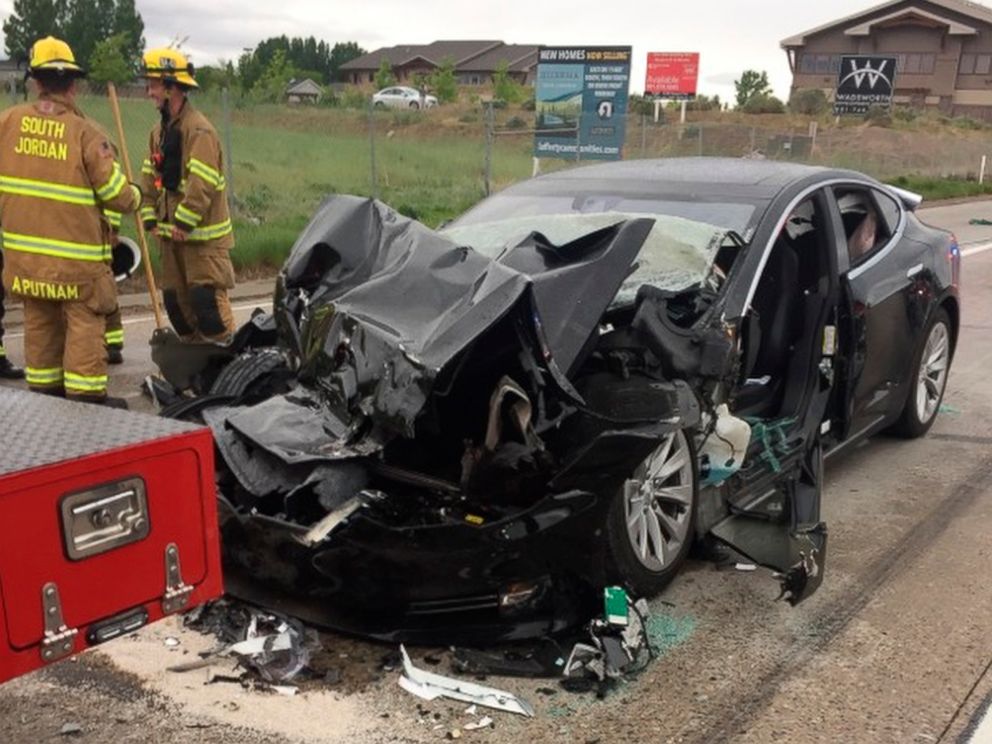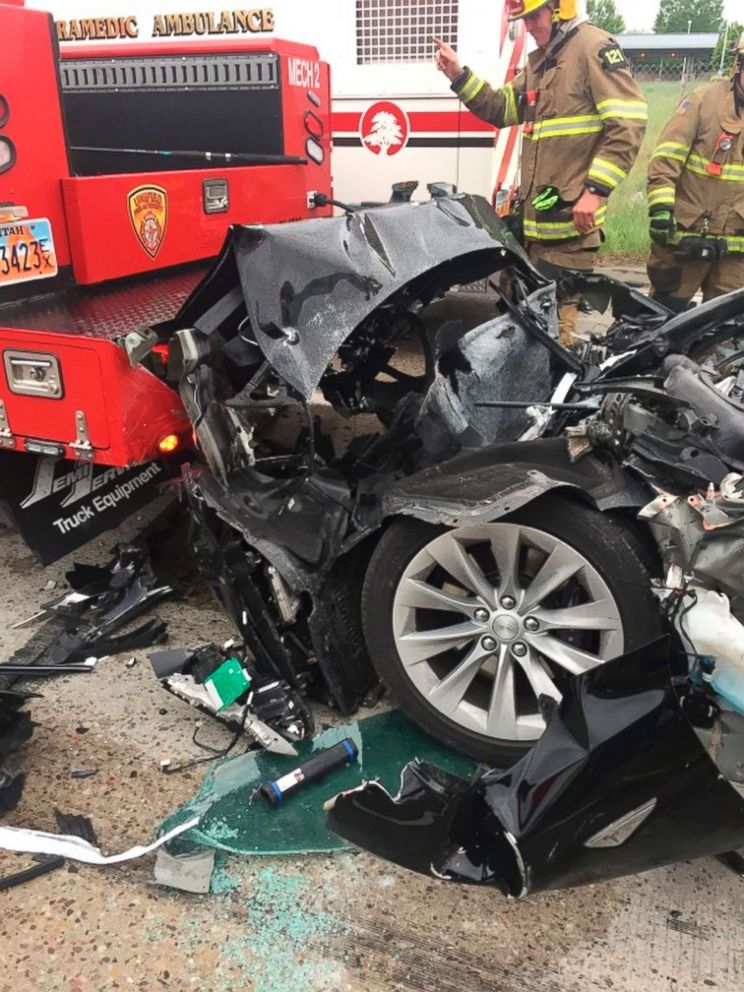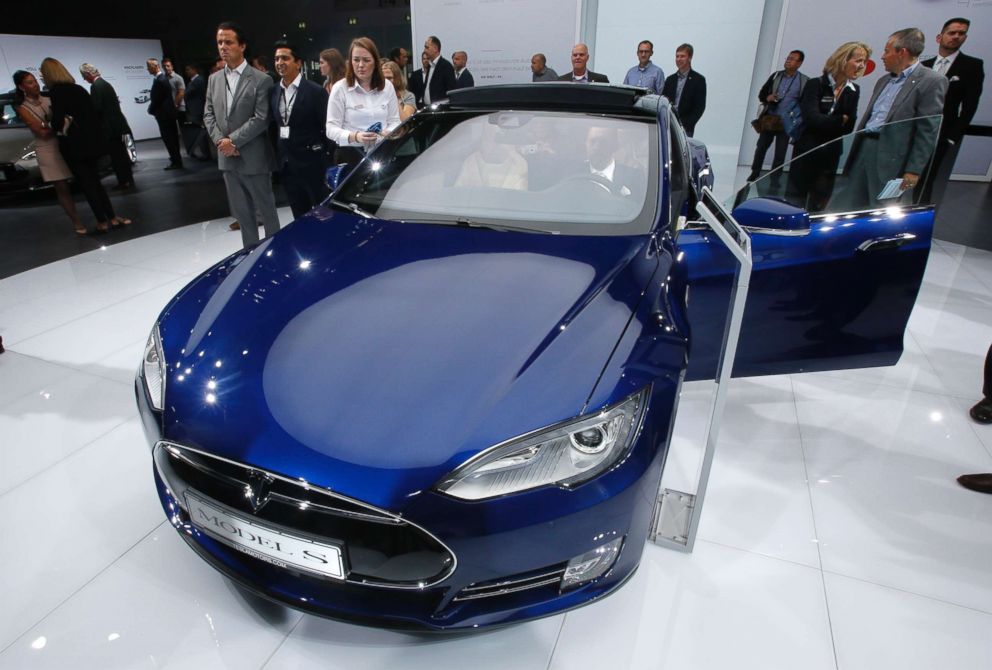Utah driver who slammed her Tesla into a firetruck sues the carmaker over Autopilot feature
"Because right now Tesla is not ready for autopilot," driver's lawyer says.
The woman who crashed her Tesla into a firetruck while the car was in autopilot mode is suing the electric carmaker, alleging the feature is defective and that the company’s marketing is misleading, the driver's lawyer said.
"They [Tesla] need to go away from autopilot to assisted driving,” Jeffery Metler, the driver's lawyer, told ABC News. “Because right now Tesla is not ready for autopilot. So they’re trying to lay the blame at the feet of the drivers, which is what they’ve done for every crash."
Tesla has previously said Autopilot is an advanced driver-assistance system and not a self-driving system. But the website’s Autopilot section states: “All Tesla vehicles produced in our factory, including Model 3, have the hardware needed for full self-driving capability at a safety level substantially greater than that of a human driver.”
Tesla issued a statement in response to the lawsuit, saying, "When using Autopilot, drivers are continuously reminded of their responsibility to keep their hands on the wheel and maintain control of the vehicle at all times. Tesla has always been clear that Autopilot doesn’t make the car impervious to all accidents."
Tesla also issued a statement to ABC News, saying, “the feedback that we get from our customers shows that they have a very clear understanding of what Autopilot is, how to properly use it, and what features it consists of.”

The accident involving Metler’s client, Heather Lommatzsch, is one of several recent crashes involving Tesla's Autopilot feature. In March, Walter Huang, a 38-year old engineer at Apple, died after his Model X crash. In an unusual move, the company released details in a blog post defending Autopilot’s safety record, drawing ire from the National Transportation and Safety Board (NTSB), which told reporters, “NTSB is unhappy with the release of investigative information by Tesla."
Then in June, a Tesla sedan in Autopilot mode crashed in Laguna Beach, California, resulting in minor injuries. The NTSB has launched at least three investigations into accidents related to Tesla’s Autopilot function.
"They claim it’s an autopilot car,” Metler added. “They put out a message that’s not consistent. That leaves the public relying on the safety of the cars but I don’t think the technology is to the point that people can safely rely on it.”
Lommatzsch, 29, says she crashed her Tesla S on May 11 while in Autopilot mode into the stopped firetruck in South Jordan, a Salt Lake City suburb.
She also says she was on phone at the time of the crash.

Drivers who are using their phones during an accident are usually at fault, Metler said. But because of Tesla’s Autopilot, "we look at it and think it was reasonable to trust the safety features the way it was advertised. Those safety features failed her," he added.
She suffered injuries to her right foot after repeated attempts to break before the crash, Metler said.
"She tried to break multiple times, laying on the break," he said, adding that Lommatzsch has had two surgeries and a bone graft for her foot and may need another as a result of the crash."
She is a real estate agent who has been unable to work, or drive or otherwise put weight on her foot since the accident, Metler said. "She is homebound," he added.
She is suing for at least $300,000 in damages.
Lommatzsch bought the car from a Tesla dealership in Utah in 2016 and has been the car's sole owner, Metler said.

She had never had problems with the Autopilot feature before the May crash but the car had been serviced by Service King Collision Repair prior to the crash, the lawyer said, adding that he did not know what work had been performed
Service King Collision and Tesla Motors UT Inc. are the other two defendants named in the suit. Neither immediately responded to ABC News’ request for comment.
Tesla "knew or should have known that the product was unreasonably dangerous to users," according to Lommatzsch's suit, filed Tuesday in Utah's Third District Court in Salt Lake County.
"Based on conversations with Tesla salespeople," Lommatzsch thought the "Model S's safety features would ensure the vehicle would stop on its own in the event of an obstacle being present in the path of the Tesla Model S,” according to the suit.
The Tesla salesman told her "she could drive in Autopilot mode and just touch the steering wheel occasionally,” the suit alleges.
The South Jordan Police Department report cited information provided by Tesla about the car: "Drivers are repeatedly advised Autopilot features do not make Tesla vehicles "autonomous" and that the driver absolutely must remain vigilant with their eyes on the road, hands on the wheel and they must be prepared to take any and all action necessary to avoid hazards on the road."
The police report also cites Tesla's account that the car "registered more than a dozen instances of her hands being off the steering wheel in this drive cycle. On two such occasions, she had her hands off the wheel for more than one minute each time and her hands came back on only after a visual alert was provided. Each time she put her hands back on the wheel, she took them back off the wheel after a few seconds," noting that for the 80 seconds before the crash, Lommatzsch had her hands off the wheel.




